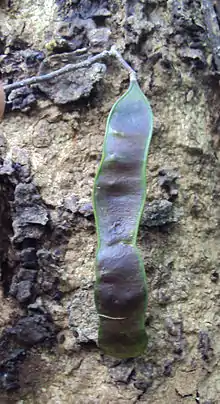Albizia chinensis
Albizia chinensis is a species of legume in the genus Albizia, native to south and southeast Asia, from India to China and Indonesia.[1]
| Albizia chinensis | |
|---|---|
 | |
| Bark of Albizia chinensis | |
| Scientific classification | |
| Kingdom: | Plantae |
| Clade: | Tracheophytes |
| Clade: | Angiosperms |
| Clade: | Eudicots |
| Clade: | Rosids |
| Order: | Fabales |
| Family: | Fabaceae |
| Subfamily: | Caesalpinioideae |
| Clade: | Mimosoideae |
| Genus: | Albizia |
| Species: | A. chinensis |
| Binomial name | |
| Albizia chinensis (Osbeck) Merr. | |
| Synonyms | |
|
List
| |
The genus is named after the Italian nobleman Filippo degli Albizzi, belonging to the famous Florentine family Albizzi, who introduced it to Europe in the mid-18th century, and it is sometimes incorrectly spelled Albizzia.


Description
Albizia chinensis is a deciduous or evergreen tree that reaches a height of up to 30–43 m. Its trunk has a diameter up to 1–2 m. Its flowers are stalked heads that aggregate into a yellow panicle. The fruits are indehiscent pods.[2]
Uses
Albizia chinensis is a browse tree, its leaves being readily eaten by goats. It is also a shade tree in plantations. It can be planted as an ornamental tree.[2]
References
- http://www.worldagroforestry.org/sea/products/afdbases/af/asp/SpeciesInfo.asp?SpID=1787#Identity
- Heuzé V., Thiollet H., Tran G., Lebas F., 2018. Chinese albizia (Albizia chinensis). Feedipedia, a programme by INRA, CIRAD, AFZ and FAO. https://www.feedipedia.org/node/336